Related Research Articles

Belém Tower, officially the Tower of Saint Vincent is a 16th-century fortification located in Lisbon that served as a point of embarkation and disembarkation for Portuguese explorers and as a ceremonial gateway to Lisbon. It was built during the height of the Portuguese Renaissance, and is a prominent example of the Portuguese Manueline style, but it also incorporates hints of other architectural styles. The structure was built from lioz limestone and is composed of a bastion and a 30-metre (100 ft), four-storey tower.
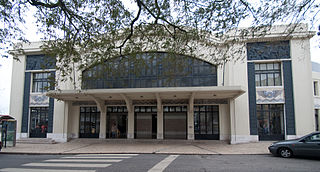
The Cais do Sodré Railway Station is an intermodal railway station in the civil parish of Misericórdia, in the municipality of Lisbon, serving as the terminus of the suburban route to the resort town Cascais.
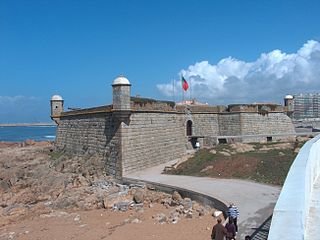
Fort of São Francisco do Queijo, frequently shortened to Castle of the Cheese is a fortification situated along the coast of the civil parish of Nevogilde in the northern Portuguese municipality of Porto.

The Fort of Guincho, also known as the Fort of Velas, is located at the edge of the Praia do Abano, along the southern edge of the coast of the civil parish of Alcabideche, in Cascais Municipality, Lisbon District, Portugal.. It was classified as Property of Public Interest by the national government on 29 September 1977, but today stands in a state of decay, even after studies to remodel the location as a visitors centre for the nearby Sintra-Cascais Nature Park.
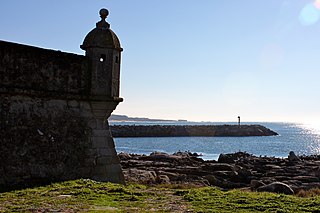
The Fort of Lagarteira is a medieval fort in the civil parish of Vila Praia de Âncora, municipality of Caminha in the Portuguese Norte, classified as a Property of Public Interest.

The Santa Marta Lighthouse is situated to the south of the centre of Cascais, Lisbon District, Portugal, on the estuary of the River Tagus, providing a light for the Cascais Bay and for the town's new marina. It is a quadrangular masonry tower covered with white tiles, with blue horizontal stripes and a red lantern. The lighthouse was built on the grounds of the Santa Marta Fort, which now houses a lighthouse museum.

The Fort of Saint Anthony of Barra is located overlooking the sea, in the parish of Estoril, Cascais municipality, District of Lisbon, in Portugal. It is sometimes known as the Old Fort ), or as the Fort of Salazar as it was used by the Prime Minister, António de Oliveira Salazar as his seasonal residence during the Portuguese dictatorship. Until early 2018 the fort had been disused and subject to some vandalism, but it was then restored by the Municipality and opened for public viewing for the first time on April 25, 2018.

The São Julião da Barra Fort is the largest and most complete military defense complex in the Vauban style remaining in Portugal. It is located in São Julião da Barra, on the point of São Gião, in the parish of Oeiras e São Julião da Barra, Paço de Arcos e Caxias, Oeiras Municipality, Lisbon District. Considered in the past as the most important maritime fortification in the country, it had originally, together with the Fort of São Lourenço do Bugio, the role of controlling access to the port of Lisbon. It is currently the official residence of the Portuguese Minister of National Defence.

The Fort of São Lourenço do Bugio, also known as the fort of São Lourenço da Cabeça Seca or simply Torre do Bugio, is located in the middle of the estuary of the river Tagus, near Lisbon in Portugal. With no further need for its military functions, it is presently a lighthouse. The fort’s location is on a sandbank formed by the silting of the river mouth, the result of the meeting of the river’s waters with those of the Atlantic Ocean. Being the only sandbar in the Tagus with its surface above the tide throughout the year, it was given the name “dry head”. The derivation of the name “Bugio” (monkey) is uncertain but may be related to the French word for candle, “bougie”, due to the similarity of the fort’s structure with a candle on a candlestick.

The Fort of São Bruno is situated on the estuary of the River Tagus in Caxias, Oeiras municipality, near Lisbon in Portugal. It was built in 1647 and became operational in 1649 as part of the construction of a line of forts to control access to Lisbon, which stretched from Cabo da Roca on the Atlantic coast to the Belém Tower near Lisbon. The fort is well preserved, following its original design, and is considered one of the most attractive examples of maritime military architecture on the Portuguese coast. It presently serves as the headquarters of the Associação Portuguesa dos Amigos dos Castelos.
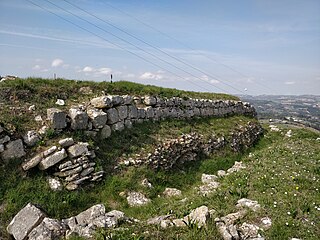
The Fort of Ribas, also known as the Redoubt of Ribas and the Redoubt of Freixial Alto, is one of a group of fortifications in Portugal that made up the second of the three defensive Lines of Torres Vedras, between the Atlantic Ocean and the River Tagus, which were designed to protect the capital, Lisbon, from possible invasion by French troops during the Peninsular War. It was designed for a garrison of 300 soldiers, with three or four cannon. The fort is situated near the town of Bucelas in the Lisbon District of Portugal.

The Fort of Casa was the most easterly of the forts and redoubts built in 1809-10 during the Peninsular War on the second line of the three defensive Lines of Torres Vedras aimed at protecting the capital of Portugal, Lisbon. It is situated in the town of Forte da Casa, in the municipality of Vila Franca de Xira, in the Lisbon District.

The Forts of Serra da Aguieira were three forts constructed within 100 metres of each other as part of the second line of defence of the so-called Lines of Torres Vedras, which were constructed by Anglo-Portuguese forces in 1810 in order to protect the Portuguese capital Lisbon from possible invasion by the French during the Peninsular War. The forts are situated in the municipality of Vila Franca de Xira, in the Lisbon District of Portugal. From north to south the three forts are the Fort of Aguieira, the Fort of Portela Grande, and the Fort of Portela Pequena.

The Fort of Arpim is in the parish of Bucelas in the municipality of Loures, in the Lisbon District of Portugal. It was constructed during the Peninsular War, forming part of the first of three defensive Lines of Torres Vedras aimed at protecting Lisbon, the capital of Portugal, from French invasion. The fort, which never saw battle, has been restored and can be visited.

The Redoubt of Mount Cintra, commonly known as the Fort of Sacavém, is located in the town of Sacavém in the municipality of Loures in the Lisbon District of Portugal. It is situated immediately to the north of Lisbon. The fort’s construction began in 1875 and was completed in 1892. Since 2015 it has served as the National Archive for Portugal’s Directorate General of Cultural Heritage (DGPC).

The Fort of Archeira is located in the municipality of Torres Vedras, in the Lisbon District of Portugal. It is also today known as the Furadouro Redoubt and was called the “Cheira” at the time of construction. Construction began in 1810 as part of the first of the three Lines of Torres Vedras, which were defensive lines to protect the Portuguese capital Lisbon from invasion by the French during the Peninsular War (1807–14) or, in the event of defeat, to protect the embarkation of a retreating British Army.

The Fort of Bom Sucesso is located slightly to the west of the Belém Tower in Belém in the municipality of Lisbon, in Portugal. It now houses the Museu do Combatente and the Monument to Overseas Combatants.
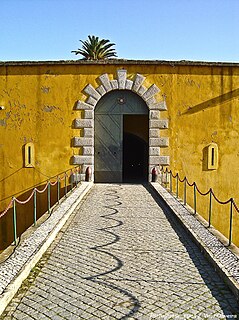
The Campo Entrincheirado is a group of fortifications built at the end of the 19th century and beginning of the 20th century to protect the Portuguese capital, Lisbon, against invasion. It followed the boundaries of the city at that time.

The Fort of Monsanto, also known as the Marquês de Sá da Bandeira Fort, is located at the top of the Monsanto hill in the Monsanto Forest Park, in Lisbon, Portugal. Built at the end of the 19th century as part of Lisbon's Campo Entrincheirado defensive ring around the city, the fort is now a maximum-security prison.
The Fort of Trafaria is a fort in Portugal. Dating back to 1683, it has never been used in battle.
References
- 1 2 "CEL - Forte do Alto do Duque". Monumentos de História. Retrieved 24 November 2020.
- 1 2 3 4 "Forte do Alto do Duque". Fortalezas.org. Retrieved 24 November 2020.
- ↑ "Forte do Alto do Duque". Patrimonio Cultural. Retrieved 24 November 2020.
- 1 2 "Forte do Alto do Duque". SIPA: Sistema de Informação para o Património Arquitetónico. Retrieved 24 November 2020.
- ↑ "Arquivo de etiquetas: Forte do Alto do Duque: Ainda a 1ª experiência de TSF em Portugal". História das Transmissões Militares. Retrieved 24 November 2020.
